All genres
241.
Talk
Unidirectional solidification and single crystal growth of Al-rich Ti–Al alloys. MRS Fall Meeting 2008, Boston, MA, USA (2008)
242.
Talk
Ab inito study on elastic properties of Fe3Al-based alloys. MRS Fall Meeting 2008, Boston, MA, USA (2008)
243.
Talk
Forging of steam turbine blades with and Fe3Al-based alloy. MRS Fall Meeting 2008, Boston, MA, USA (2008)
244.
Talk
Precipitation reactions in Ti40Al60 and Ti38Al62 alloys and symmetry relations of the phases involved. MRS Fall Meeting 2008, Boston, MA, USA (2008)
245.
Talk
Structure and disorder of the Laves phases in the Co–Nb system. MRS Fall Meeting 2008, Boston, MA, USA (2008)
246.
Talk
An in-situ electron microscopy study of microstructural evolution in a Co–Co2Nb binary alloy. MRS Fall Meeting 2008, Boston, MA, USA (2008)
247.
Talk
Structure and unusual mechanical behaviour of the intermetallic compound Nb2Co7. MRS Fall Meeting 2008, Boston, MA, USA (2008)
248.
Talk
Composition Dependence of the Mechanical Properties of Laves Phases in the Binary Nb–Fe and the Ternary Nb–Fe–Al System. MRS Fall Conference 2008, Boston, MA, USA (2008)
249.
Talk
Investigation of the crystallographic structure of the ε phase in the Fe–Al system by high-temperature neutron diffraction. 20th Annual Rio Grande Symposium on Advanced Materials 2008, Albuquerque, NM, USA (2008)
250.
Talk
Fe–Al-based materials for structural applications at high temperatures. ISPMA, Prague, Czech Republic (2008)
251.
Talk
Nb-based Laves phases - Stability, structure and disorder. 16th Int. Conf. Solid Compounds of Transition Elements SCTE 2008, Dresden, Germany (2008)
252.
Talk
Preliminary in-situ TEM observations of phase transformations in a Co–15 at.% Nb alloy. Workshop "The Nature of Laves Phases XI", MPIE Düsseldorf, Germany (2008)
253.
Talk
Phase equilibria in the Cr–Ti system studied by diffusion couples and equilibrated two-phase alloys. Workshop "The Nature of Laves Phases XI", MPI für Eisenforschung, Düsseldorf, Germany (2008)
254.
Talk
Phase equilibria of Laves phases in ternary Nb–X–Al systems with X = Cr, Fe, Co. Discussion Meeting on Thermodynamics of Alloys - TOFA 2008, Krakow, Poland (2008)
255.
Talk
Creep strength of centrifugally cast Al-rich TiAl alloys. 11th Int. Conf. on Creep and Fracture of Engineering Materials and
Structures
, Bayreuth, Germany (2008)
256.
Talk
Investigation of the crystallographic structure of the ε phase in the Fe–Al system by high-temperature neutron diffraction. American Conference on Neutron Scattering (ACNS 2008), Santa Fe, New Mexico, USA (2008)
257.
Talk
Phase equilibria and phase transformations of Laves phases in the Cr–Ti binary system. JIM Annual Spring Meeting 2008, Tokyo, Japan (2008)
258.
Talk
The influence of Cr and B additions on the mechanical properties and oxidation behaviour of L21-ordered Fe–Al–Ti based aluminides at high temperature. TMS Annual Meeting 2008, New Orleans, LA, USA (2008)
259.
Talk
Properties of cast Al-rich Ti–Al alloys. TMS Annual Meeting 2008, New Orleans, LA. USA (2008)
260.
Talk
Evaluation of the Brittle-to-Ductile Transition Temperature (BDTT)and the fracture modes in Fe–Al–X alloys. 4th Discussion Meeting on the Development of Innovative Iron Aluminium Alloys, Interlaken, Switzerland (2007)











